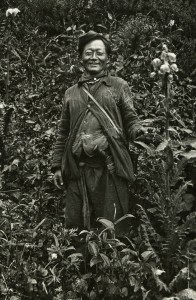
Lepchas are indigenous peoples to Sikkim, renowned for their knowledge of and respect for nature. Several Lepcha were employed as collectors by the Calcutta Botanic Garden.
Rhomoo Lepcha first enrolled in the Botanical Survey of India then moved to the Lloyd Botanical Garden, Darjeeling, before finally working for G. Ghose and Company.
Rhomoo and another Lepcha collector, Ribu, headed up a team of collectors who followed William Wright Smith and George H. Cave’s botanical exploration of Sikkim during 1909–191 collecting seed. Rhomoo then became chief collector during Roland Edgar Cooper’s trips to Sikkim (1913), Bhutan (1914 & 1915) finally in Pubjab (1916), in an area now part of Himachal Pradesh.
A number of Rhomoo’s collection have been used as Type material.
R.E. Cooper recalled from his Sikkim trip in 1913 that his own pass did not allow him into the Chumbi Valley but Rhomoo was able to enter and [re]collect a primula that what would become known Primula chumbiensis described by William Wright Smith based on material Rhomoo had collected in Chumbi during 1912.
Rhomoo was botanically commorated by Henry Noltie during the writing of the Flora of Bhutan with Poa rohmooana Noltie.
